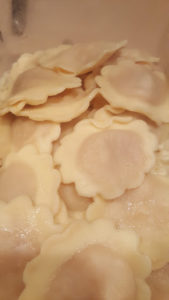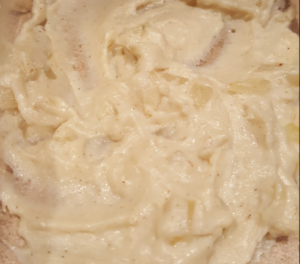 Half of this recipe is a cop out as I just bought pre-made butternut squash ravioli this time. A ravioli recipe will come soon though – after making fresh ravioli I had told myself I would never go back because it’s just SO good…not even in the same echelon as pre-made…BUT sometimes you get lazy and if your local farmers market offers their own fresh ravioli y’know…
Half of this recipe is a cop out as I just bought pre-made butternut squash ravioli this time. A ravioli recipe will come soon though – after making fresh ravioli I had told myself I would never go back because it’s just SO good…not even in the same echelon as pre-made…BUT sometimes you get lazy and if your local farmers market offers their own fresh ravioli y’know…
The other half though is a big rant about the importance of a roux>bechamel which is the foundation of what these bad boys (raviolis) will be rolling in…
My mum taught me that a roux is one of the most important things to learn how to cook. It is the base for so much, if you are unfamiliar let’s get into a little cookin’ principles. A roux is basically a mix of flour and fat (oil/butter), it acts as a thickener for sauces and is the core of a bechamel (roux+milk), and a mornay (roux+milk+cheese) and many other crucial saucy things like a veloute, gravies and more. Basically, if you haven’t already – you have to make a roux. It is so much fun and will be the kick off point for sooo much amazing cooking. Here’s my quick ( + probably traditionally flawed) method:
 Pop a blob of butter and a bit of oil in a saucepan and turn the heat on low to melt the butter. Add in a couple tablespoons of all purpose flour and mix together until you have some paste the consistency of toothpaste. At this point you have a roux. To turn it into a bechamel add in a splash of milk and mix like crazy until mixed in and smooth. Keeping the heat to low, add another splash, whisk. You will see the sauce begin to thicken and it is a very satisfying process. Repeat and repeat adding milk and whisking until thickened. The key is then just knowing when to stop, you will see that the sauce will begin to respond less to the whisking and it will stop thickening as quickly. I’ve included more specific proportions in the recipe to help out until you can feel it our for yourself and here’s a vid on bbc goodfood. Usually a tablespoon or two of paste will give me about a third a saucepan of sauce (perfect for most meals for 2).
Pop a blob of butter and a bit of oil in a saucepan and turn the heat on low to melt the butter. Add in a couple tablespoons of all purpose flour and mix together until you have some paste the consistency of toothpaste. At this point you have a roux. To turn it into a bechamel add in a splash of milk and mix like crazy until mixed in and smooth. Keeping the heat to low, add another splash, whisk. You will see the sauce begin to thicken and it is a very satisfying process. Repeat and repeat adding milk and whisking until thickened. The key is then just knowing when to stop, you will see that the sauce will begin to respond less to the whisking and it will stop thickening as quickly. I’ve included more specific proportions in the recipe to help out until you can feel it our for yourself and here’s a vid on bbc goodfood. Usually a tablespoon or two of paste will give me about a third a saucepan of sauce (perfect for most meals for 2).
There are different variations to how you can make your bechamel, some choose to add the milk to the roux and some visa versa. Many cajun recipes call for a darker roux that stays on the heat for longer and starts to darken and change flavour. You can even freeze your roux to add as a thickener for whenever you need it. I totally have a hard on for sauce making in case you haven’t noticed so I want to encourage you to use this foundation to make other creamy sauces with interesting flavor combos – I always add garlic for my lasagna bech – what about infusing the milk with honey? White truffle oil in your initial roux mix? Mmm, the possibilities!
Some tips: It’s best to stir constantly though my mum told me about her french landlady from years past that used to say ‘don’t worry, you can always whisk out ze lumps! Always!” And for some reason this passes through my mind anytime I am whisking – so if you don’t have a super smooth sauce don’t worry, just keep whisking away!
Here is one awesome seasonal sauce recipe utilizing the almighty roux. When I made it I intentionally left the bechamel a tad thicker to account for adding the raviolis in with a little pasta water to loosen it up. Finish with parmesan!
Sage Bechamel

- 2 tbsp all-purpose flour
- 2 tbsp butter, melted
- a dash of olive oil (to help ensure the butter doesn’t burn)
- 2 cups milk
- onions, 1/3 cup minced
- 1 tsp freshly grated nutmeg
- 1 tsp ground sage
- dash of white pepper
- salt to taste
Sautee minced onions. Make bechamel. Add in sauteed onions and a teaspoon of freshly grated nutmeg, and a teaspoon of ground sage (if you have fresh sage that is so great, put about 2 leaves in earlier and let it get all up in there and just pick out the leaves before serving or infuse it with the milk before hand), salt and white pepper to taste.
Word of warning, salt makes or breaks a good bechamel. The perfect amount of salt makes a bechamel an irresistible cream fest of deliciousness, but just a dash to much and it’s a sad over salted mess – the constant taste test is crucial.